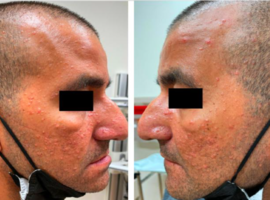Sophia Manduca1 and Genevieve Kaunitz2*
1New York University Grossman School of Medicine, New York, NY, USA
2Department of Dermatology, University of California San Diego School of Medicine, San Diego, CA, USA
*Corresponding author: Genevieve Kaunitz, Department of Dermatology, University of California San Diego School of Medicine, San Diego, CA, USA.
E-mail: gkaunitz@health.ucsd.edu
Received: August 11, 2025; Accepted: August 30, 2025; Published: September 15, 2025
Citation: Manduca S, Kaunitz G. Managing Cyclosporine-Induced Sebaceous Hyperplasia in a Renal Transplant Patient: Efficacy of Oral Isotretinoin. Clin Image Case Rep J. 2025; 7(6): 576.


